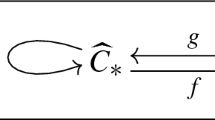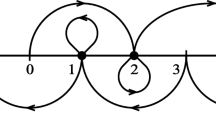Abstract
Let G be a group which admits the structure of an iterated product of central extensions and semidirect products of abelian groups G i (both finite and infinite). We describe a Mathematica 4.0 notebook for computing the homology of G, in terms of some homological models for the factor groups G i and the products involved. Computational results provided by our program have allowed the simplification of some of the formulae involved in the calculation of H n (G). Consequently the efficiency of the method has been improved as well. We include some executions and examples.
Preview
Unable to display preview. Download preview PDF.
Similar content being viewed by others
References
Álvarez, V.: http://mathworld.wolfram.com/HomologyIteratedGroups.html (to appear, 2006)
Álvarez, V., Armario, J.A., Frau, M.D., Real, P.: A genetic algorithm for cocyclic Hadamard matrices. In: Fossorier, M.P.C., Imai, H., Lin, S., Poli, A. (eds.) AAECC 2006. LNCS, vol. 3857, pp. 144–153. Springer, Heidelberg (2006)
Álvarez, V., Armario, J.A., Frau, M.D., Real, P.: (Co)homology of iterated products of semidirect products of abelian groups. In: Ganzha, V.G., Mayr, E.W., Vorozhtsov, E.V. (eds.) CASC 2006. LNCS, vol. 4194. Springer, Heidelberg (2006)
Álvarez, V., Armario, J.A., Frau, M.D., Real, P.: Comparison maps for relatively free resolutions. In: Ganzha, V.G., Mayr, E.W., Vorozhtsov, E.V. (eds.) CASC 2006. LNCS, vol. 4194, pp. 1–22. Springer, Heidelberg (2006)
Carlson, J.: http://www.math.uga.edu/~jfc/
Dousson, X., Rubio, J., Sergeraert, F., Siret, Y.: The KENZO program. Institute Fourier, Grenoble (1998), http://www-fourier.ujf-grenoble.fr/~sergeraert/Kenzo/
Dumas, J.G., Heckenbach, F., Saunders, D., Welker, V.: Computing simplicial homology based on efficient smith normal form algorithms. In: Algebra, Geometry and Software Systems, pp. 177–204. Springer, Heidelberg (2003)
Eilenberg, S., Mac Lane, S.: On the groups H(π, n) II. Annals of Math 66, 49–139 (1954)
The GAP group, GAP- Group, Algorithms and programming, School of Mathematical and Computational Sciences, University of St. Andrews, Scotland (1998)
Grabmeier, J., Lambe, L.A.: Computing Resolutions Over Finite p-Groups. In: Betten, A., Kohnert, A., Lave, R., Wassermann, A. (eds.) Proceedings ALCOMA 1999. Lecture Notes in Computational Science and Engineering. Springer, Heidelberg (2000)
Ellis, G.: GAP package HAP, Homological Algebra Programming, http://hamilton.nuigalway.ie/Hap/www/
Huebschmann, J.: Cohomology of nilpotent groups of class 2. J. Algebra 126, 400–450 (1989)
Huebschmann, J.: Cohomology of metacyclic groups. Transactions of the American Mathematical Society 328(1), 1–72 (1991)
Jabon, D.: http://mathworld.wolfram.com/SmithNormalForm.html (1994)
Lambe, L.A.: Algorithms for the homology of nilpotent groups. In: Conf. on applications of computers to Geom. and Top., Lecture Notes in Pure and Applied Math., vol. 114, Marcel Dekker Inc., N.Y (1989)
Lambe, L.A.: Homological perturbation theory, Hochschild homology and formal groups. In: Proc. Conference on Deformation Theory and Quantization with Applications to Physics, Amherst, MA, June 1990. Cont. Math, vol. 134, pp. 183–218 (1992)
Lambe, L.A., Stasheff, J.D.: Applications of perturbation theory to iterated fibrations. Manuscripta Math. 58, 367–376 (1987)
The MAGMA computational algebra system, http://magma.maths.usyd.edu.au
Real, P.: Homological Perturbation Theory and Associativity. Homology, Homotopy and Applications 2, 51–88 (2000)
Rubio, J.: Integrating functional programming and symbolic computation. Mathematics and computers in simulation 44, 505–511 (1997)
Sergeraert, F.: The computability problem in Algebraic Topology. In: Advances in Math., vol. 1104, pp. 1–29 (1994)
Veblen, O.: Analisis situs, vol. 5. A.M.S. Publications, Providence, RI (1931)
Author information
Authors and Affiliations
Editor information
Editors and Affiliations
Rights and permissions
Copyright information
© 2006 Springer-Verlag Berlin Heidelberg
About this paper
Cite this paper
Álvarez, V., Armario, J.A., Frau, M.D., Real, P. (2006). A Mathematica Notebook for Computing the Homology of Iterated Products of Groups. In: Iglesias, A., Takayama, N. (eds) Mathematical Software - ICMS 2006. ICMS 2006. Lecture Notes in Computer Science, vol 4151. Springer, Berlin, Heidelberg. https://doi.org/10.1007/11832225_5
Download citation
DOI: https://doi.org/10.1007/11832225_5
Publisher Name: Springer, Berlin, Heidelberg
Print ISBN: 978-3-540-38084-9
Online ISBN: 978-3-540-38086-3
eBook Packages: Computer ScienceComputer Science (R0)




